Studying Conformational Properties of Transmembrane Domain of KCNE3 in a Lipid Bilayer Membrane Using Molecular Dynamics Simulations
Abstract
1. Introduction
2. Methods
2.1. Molecular Dynamics Modeling of KCNE3 in Lipid Bilayers
2.2. Analysis of the MD Simulation Data
2.2.1. Calculation of MD Simulation Output Parameters
2.2.2. Helical Bending Angle Calculation
2.2.3. Principal Component Analysis
3. Results
3.1. Stability of KCNE3 in POPC/POPG Lipid Bilayers
3.2. Conformational Properties of Transmembrane Domain of KCNE3 in POPC/POPG Lipid Bilayers
3.3. Effect of KCNE3 Mutations in the Formation of Lipid Bilayers
3.4. Topology of KCNE3 with Respect to Lipid Bilayers
3.5. Probability Density of Helical Tilt Angle and Z-Distance of KCNE3 TMD in Lipid Bilayers
3.6. Interaction Energy of Different KCNE3 Regions in Lipid Bilayers
4. Discussion
5. Conclusions
Supplementary Materials
Author Contributions
Funding
Data Availability Statement
Acknowledgments
Conflicts of Interest
Abbreviations
References
- Abbott, G.W. KCNE1 and KCNE3: The yin and yang of voltage-gated K+ channel regulation. Gene 2016, 576, 1–13. [Google Scholar] [CrossRef]
- Lewis, A.; McCrossan, Z.A.; Abbott, G.W. MinK, MiRP1, and MiRP2 diversify Kv3.1 and Kv3.2 potassium channel gating. J. Biol. Chem. 2004, 279, 7884–7892. [Google Scholar] [CrossRef]
- Schroeder, B.C.; Waldegger, S.; Fehr, S.; Bleich, M.; Warth, R.; Greger, R.; Jentsch, T.J. A constitutively open potassium channel formed by KCNQ1 and KCNE3. Nature 2000, 403, 196–199. [Google Scholar] [CrossRef] [PubMed]
- Barro-Soria, R.; Ramentol, R.; Liin, S.I.; Perez, M.E.; Kass, R.S.; Larsson, H.P. KCNE1 and KCNE3 modulate KCNQ1 channels by affecting different gating transitions. Proc. Natl. Acad. Sci. USA 2017, 114, E7367–E7376. [Google Scholar] [CrossRef]
- Tai, K.K.; Goldstein, S.A.N. The conduction pore of a cardiac potassium channel. Nature 1998, 391, 605–608. [Google Scholar] [CrossRef] [PubMed]
- Ketchum, K.A.; Joiner, W.J.; Sellers, A.J.; Kaczmarek, L.K.; Goldstein, S.A.N. A new family of outwardly rectifying potassium channel proteins with 2 pore domains in tandem. Nature 1995, 376, 690–695. [Google Scholar] [CrossRef]
- Kroncke, B.M.; Van Horn, W.D.; Smith, J.; Kang, C.B.; Welch, R.C.; Song, Y.L.; Nannemann, D.P.; Taylor, K.C.; Sisco, N.J.; George, A.L.; et al. Structural basis for KCNE3 modulation of potassium recycling in epithelia. Sci. Adv. 2016, 2, e1501228. [Google Scholar] [CrossRef] [PubMed]
- Sun, J.; MacKinnon, R. Structural Basis of Human KCNQ1 Modulation and Gating. Cell 2020, 180, 340–347.e9. [Google Scholar] [CrossRef]
- Kasuya, G.; Nakajo, K. Triad interaction stabilizes the voltage sensor domains in a constitutively open KCNQ1-KCNE3 channel. bioRxiv 2021. [Google Scholar] [CrossRef]
- Asare, I.K.; Galende, A.P.; Garcia, A.B.; Cruz, M.F.; Moura, A.C.M.; Campbell, C.C.; Scheyer, M.; Alao, J.P.; Alston, S.; Kravats, A.N.; et al. Investigating Structural Dynamics of KCNE3 in Different Membrane Environments Using Molecular Dynamics Simulations. Membranes 2022, 12, 469. [Google Scholar] [CrossRef]
- Campbell, C.; Faleel, F.D.M.; Scheyer, M.W.; Haralu, S.; Williams, P.L.; Carbo, W.D.; Wilson-Taylor, A.S.; Patel, N.H.; Sanders, C.R.; Lorigan, G.A.; et al. Comparing the structural dynamics of the human KCNE3 in reconstituted micelle and lipid bilayered vesicle environments. Biochim. Et Biophys. Acta-Biomembr. 2022, 1864, 183974. [Google Scholar] [CrossRef]
- Phillips, J.C.; Braun, R.; Wang, W.; Gumbart, J.; Tajkhorshid, E.; Villa, E.; Chipot, C.; Skeel, R.D.; Kalé, L.; Schulten, K. Scalable molecular dynamics with NAMD. J. Comput. Chem. 2005, 26, 1781–1802. [Google Scholar] [CrossRef]
- MacKerell, A.D.; Bashford, D.; Bellott, M.; Dunbrack, R.L.; Evanseck, J.D.; Field, M.J.; Fischer, S.; Gao, J.; Guo, H.; Ha, S.; et al. All-atom empirical potential for molecular modeling and dynamics studies of proteins. J. Phys. Chem. B 1998, 102, 3586–3616. [Google Scholar] [CrossRef]
- MacKerell, A.D.; Feig, M.; Brooks, C.L. Improved treatment of the protein backbone in empirical force fields. J. Am. Chem. Soc. 2004, 126, 698–699. [Google Scholar] [CrossRef]
- Jo, S.; Kim, T.; Iyer, V.G.; Im, W. Software news and updates-CHARNIM-GUI: A web-based grraphical user interface for CHARMM. J. Comput. Chem. 2008, 29, 1859–1865. [Google Scholar] [CrossRef]
- Humphrey, W.; Dalke, A.; Schulten, K. VMD-Visual Molecular Dynamics. J. Mol. Graph. 1996, 14, 33–38. [Google Scholar] [CrossRef]
- Jo, S.; Kim, T.; Im, W. Automated Builder and Database of Protein/Membrane Complexes for Molecular Dynamics Simulations. PLoS ONE 2007, 2, e880. [Google Scholar] [CrossRef]
- Essmann, U.; Perera, L.; Berkowitz, M.L.; Darden, T.; Lee, H.; Pedersen, L.G. A smooth particle mesh ewald method. J. Chem. Phys. 1995, 103, 8577–8593. [Google Scholar] [CrossRef]
- Ramelot, T.A.; Yang, Y.; Sahu, I.D.; Lee, H.-W.; Xiao, R.; Lorigan, G.A.; Montelione, G.T.; Kennedy, M.A. NMR structure and MD simulations of the AAA protease intermembrane space domain indicates peripheral membrane localization within the hexaoligomer. Febs Lett. 2013, 587, 3522–3528. [Google Scholar] [CrossRef]
- Guixa-Gonzalez, R.; Rodriguez-Espigares, I.; Ramirez-Anguita, J.M.; Carrio-Gaspar, P.; Martinez-Seara, H.; Giorgino, T.; Selent, J. MEMBPLUGIN: Studying membrane complexity in VMD. Bioinformatics 2014, 30, 1478–1480. [Google Scholar] [CrossRef]
- Costa, F.; Guardiani, C.; Giacomello, A. Molecular dynamics simulations suggest possible activation and deactivation pathways in the hERG channel. Commun. Biol. 2022, 5, 165. [Google Scholar] [CrossRef]
- Bonomi, M.; Branduardi, D.; Bussi, G.; Camilloni, C.; Provasi, D.; Raiteri, P.; Donadio, D.; Marinelli, F.; Pietrucci, F.; Broglia, R.A.; et al. PLUMED: A portable plugin for free-energy calculations with molecular dynamics. Comput. Phys. Commun. 2009, 180, 1961–1972. [Google Scholar] [CrossRef]
- Bonomi, M.; Bussi, G.; Camilloni, C.; Tribello, G.A.; Banas, P.; Barducci, A.; Bernetti, M.; Bolhuis, P.G.; Bottaro, S.; Branduardi, D.; et al. Promoting transparency and reproducibility in enhanced molecular simulations. Nat. Methods 2019, 16, 670–673. [Google Scholar] [CrossRef]
- Tribello, G.A.; Bonomi, M.; Branduardi, D.; Camilloni, C.; Bussi, G. PLUMED 2: New feathers for an old bird. Comput. Phys. Commun. 2014, 185, 604–613. [Google Scholar] [CrossRef]
- Bevacqua, A.; Bakshi, S.; Xia, Y. Principal component analysis of alpha-helix deformations in transmembrane proteins. PLoS ONE 2021, 16, e0257318. [Google Scholar] [CrossRef] [PubMed]
- Bakan, A.; Dutta, A.; Mao, W.; Liu, Y.; Chennubhotla, C.; Lezon, T.; Bahar, I. Evol and ProDy for bridging protein sequence evolution and structural dynamics. Bioinformatics 2014, 30, 2681–2683. [Google Scholar] [CrossRef] [PubMed]
- Liu, W.S.; Li, H.G.; Ding, C.H.; Zhang, H.X.; Wang, R.R.; Li, J.Q. Screening potential FDA-approved inhibitors of the SARS-CoV-2 major protease 3CLpro through high-throughput virtual screening and molecular dynamics simulation. Aging-Us 2021, 13, 6258–6272. [Google Scholar] [CrossRef]
- Sansom, M.S.P.; Bond, P.J.; Deol, S.S.; Grottesi, A.; Haider, S.; Sands, Z.A. Molecular simulations and lipid-protein interactions: Potassium channels and other membrane proteins. Biochem. Soc. Trans. 2005, 33, 916–920. [Google Scholar] [CrossRef]
- Sahu, I.D.; Craig, A.F.; Dunagum, M.M.; McCarrick, R.M.; Lorigan, G.A. Characterization of bifunctional spin labels for investigating the structural and dynamic properties of membrane proteins using EPR spectroscopy. J. Phys. Chem. B 2017, 121, 9185–9195. [Google Scholar] [CrossRef] [PubMed]
- Weng, J.; Wang, W. Molecular Dynamics Simulation of Membrane Proteins. In Protein Conformational Dynamics; Han, K.-l., Zhang, X., Yang, M.-j., Eds.; Springer: Cham, Switzerland, 2014; Volume 805, pp. 305–329. [Google Scholar]
- Muller, M.P.; Jiang, T.; Sun, C.; Lihan, M.Y.; Pant, S.; Mahinthichaichan, P.; Trifan, A.; Tajkhorshid, E. Characterization of Lipid-Protein Interactions and Lipid-Mediated Modulation of Membrane Protein Function through Molecular Simulation. Chem. Rev. 2019, 119, 6086–6161. [Google Scholar] [CrossRef]
- Coey, A.T.; Sahu, I.D.; Gunasekera, T.S.; Troxel, K.R.; Hawn, J.M.; Swartz, M.S.; Wickenheiser, M.R.; Reid, R.J.; Welch, R.C.; Vanoye, C.G.; et al. Reconstitution of KCNE1 into lipid Bilayers: Comparing the structural, dynamic, and activity differences in micelle and vesicle environments. Biochemistry 2011, 50, 10851–10859. [Google Scholar] [CrossRef] [PubMed]
- Barrett, P.J.; Song, Y.; Van Horn, W.D.; Hustedt, E.J.; Schafer, J.M.; Hadziselimovic, A.; Beel, A.J.; Sanders, C.R. The Amyloid Precursor Protein Has a Flexible Transmembrane Domain and Binds Cholesterol. Science 2012, 336, 1168–1171. [Google Scholar] [CrossRef] [PubMed]
- Pandey, B.; Grover, A.; Sharma, P. Molecular dynamics simulations revealed structural differences among WRKY domain-DNA interaction in barley (Hordeum vulgare). BMC Genom. 2018, 19, 132. [Google Scholar] [CrossRef]
- Andersen, O.S.; Koeppe, R.E. Bilayer thickness and membrane protein function: An energetic perspective. Annu. Rev. Biophys. Biomol. Struct. 2007, 36, 107–130. [Google Scholar] [CrossRef] [PubMed]
- Kern, M.; Jaeger-Honz, S.; Schreiber, F.; Sommer, B. APL@voro-interactive visualization and analysis of cell membrane simulations. Bioinformatics 2023, 39, btad083. [Google Scholar] [CrossRef]
- Kasuya, G.; Nakajo, K. Optimized tight binding between the S1 segment and KCNE3 is required for the constitutively open nature of the KCNQ1-KCNE3 channel complex. Elife 2022, 11, e81683. [Google Scholar] [CrossRef]
- Al Mughram, M.H.; Catalano, C.; Herrington, N.B.; Safo, M.K.; Kellogg, G.E. 3D interaction homology: The hydrophobic residues alanine, isoleucine, leucine, proline and valine play different structural roles in soluble and membrane proteins. Front. Mol. Biosci. 2023, 10, 1116868. [Google Scholar] [CrossRef]
- Kang, C.B.; Vanoye, C.G.; Welch, R.C.; Van Horn, W.D.; Sanders, C.R. Functional Delivery of a Membrane Protein into Oocyte Membranes Using Bicelles. Biochemistry 2010, 49, 653–655. [Google Scholar] [CrossRef]
- Kandasamy, S.K.; Larson, R.G. Molecular dynamics simulations of model trans-membrane peptides in lipid bilayers: A systematic investigation of hydrophobic mismatch. Biophys. J. 2006, 90, 2326–2343. [Google Scholar] [CrossRef] [PubMed]
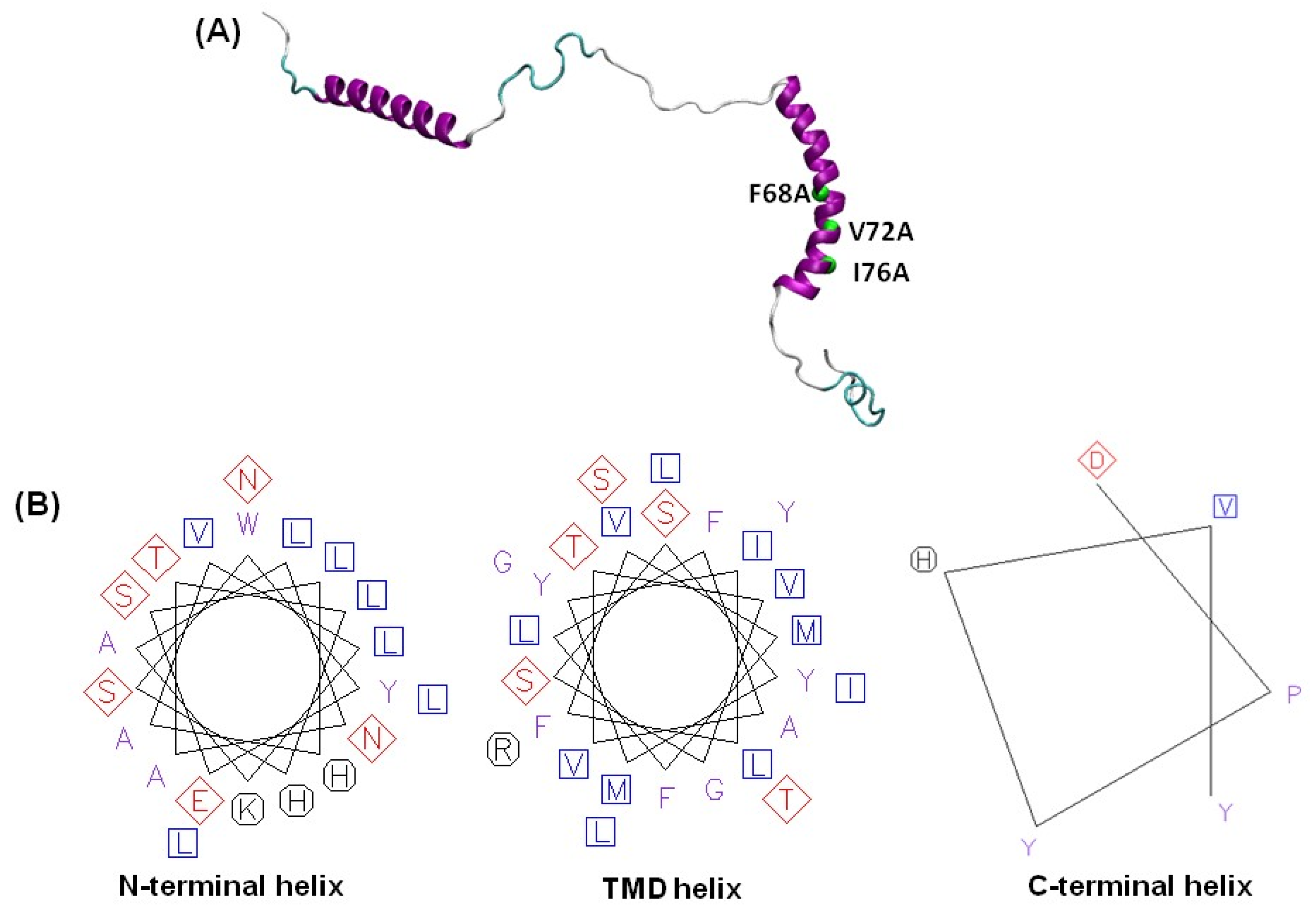

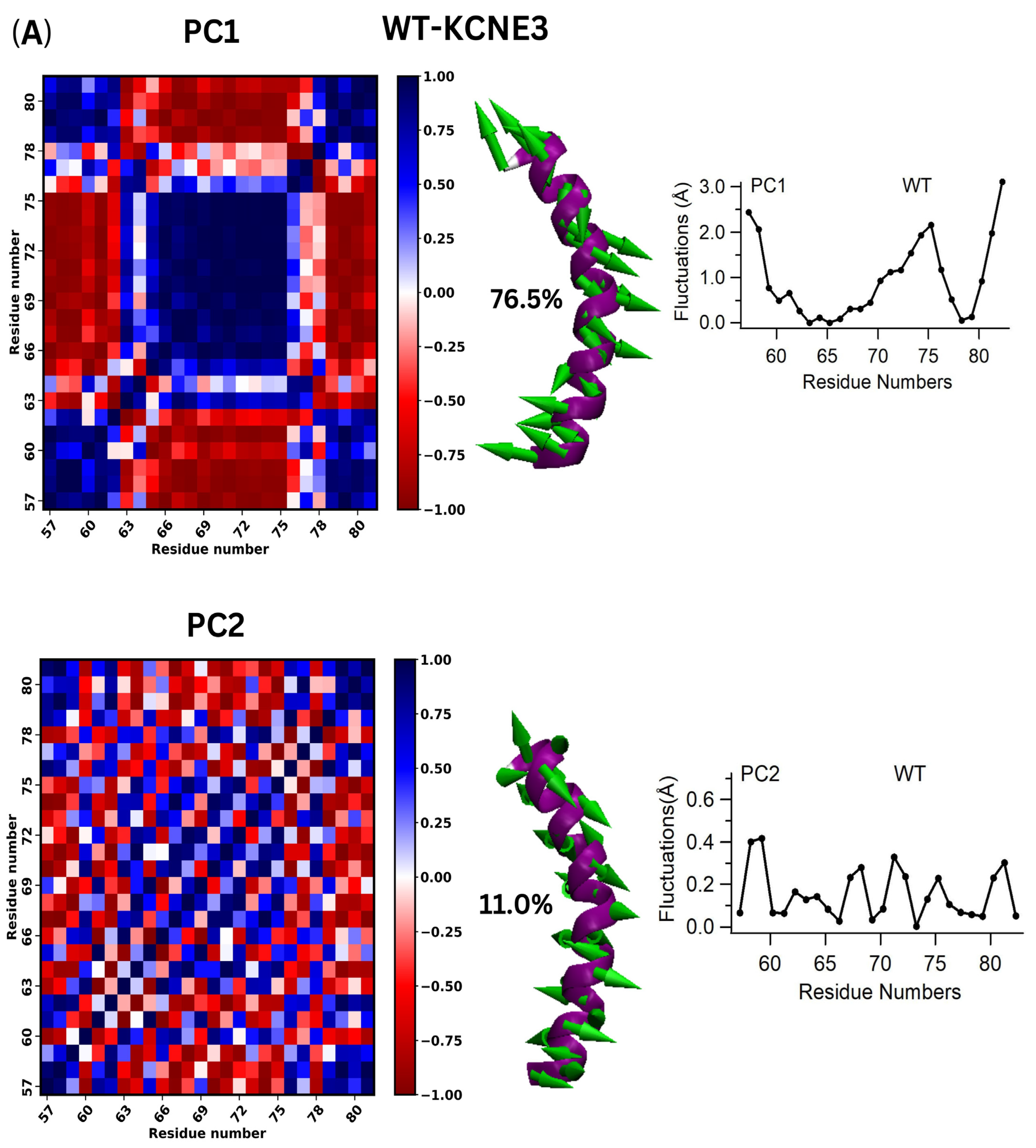

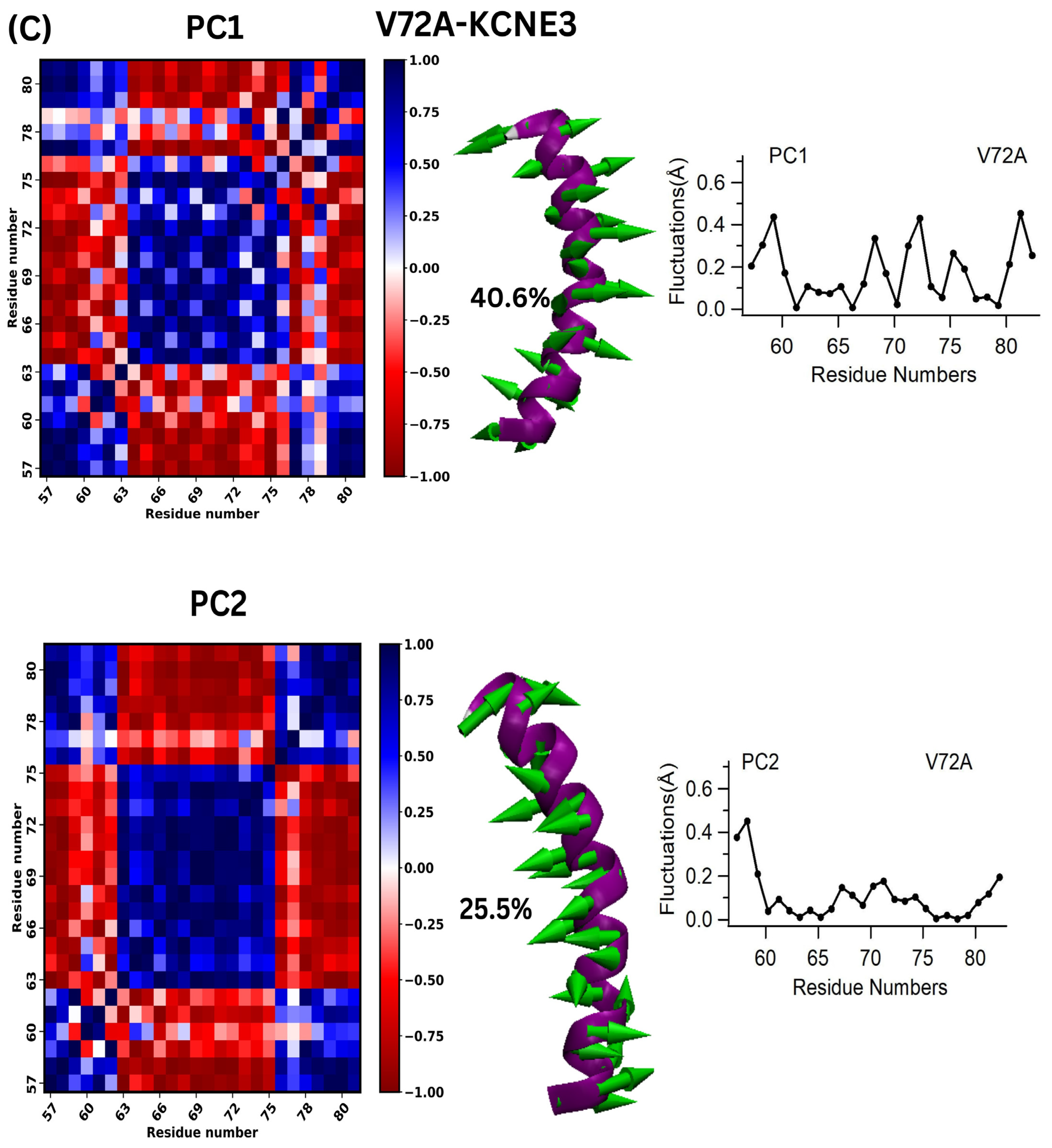
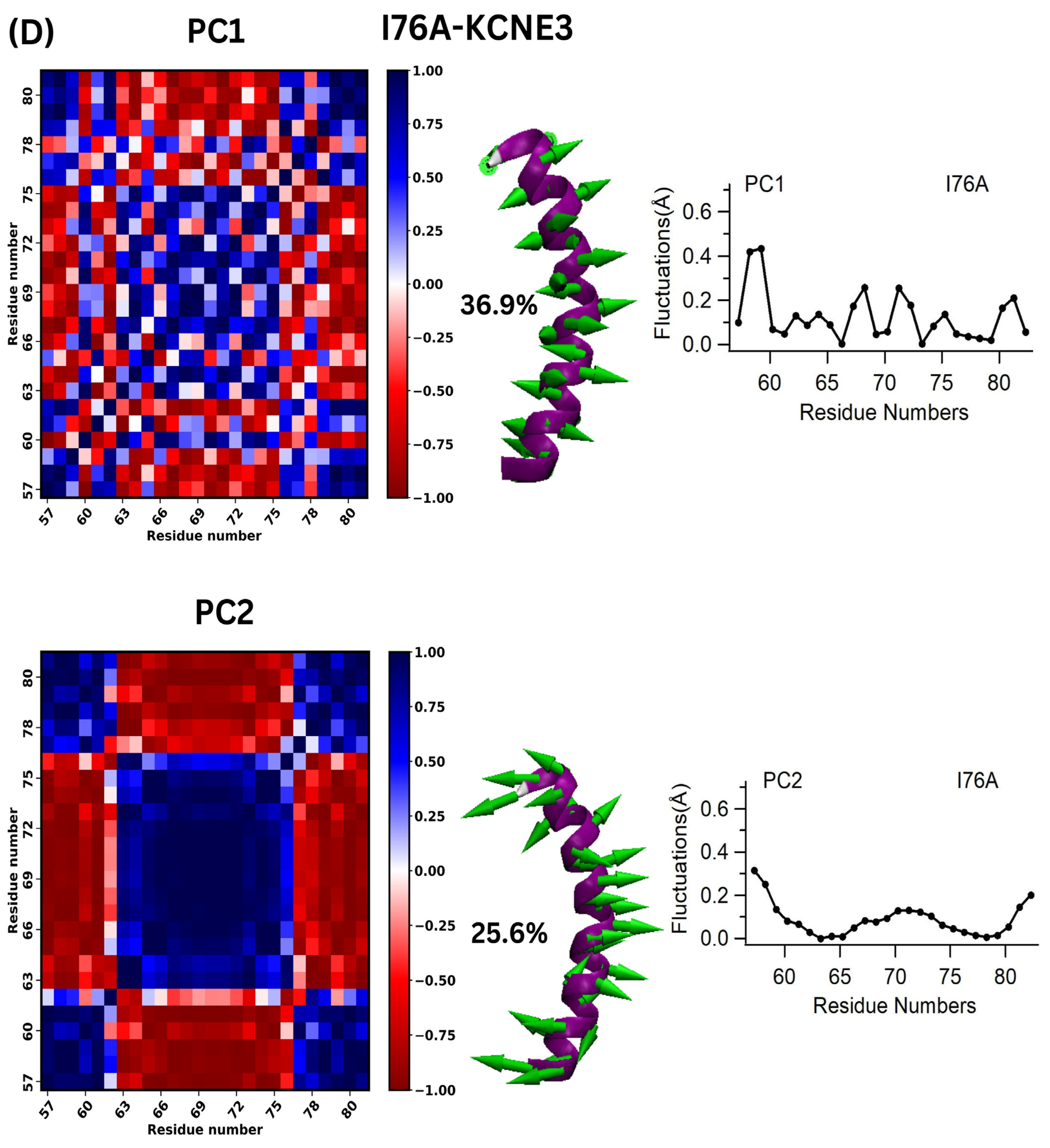
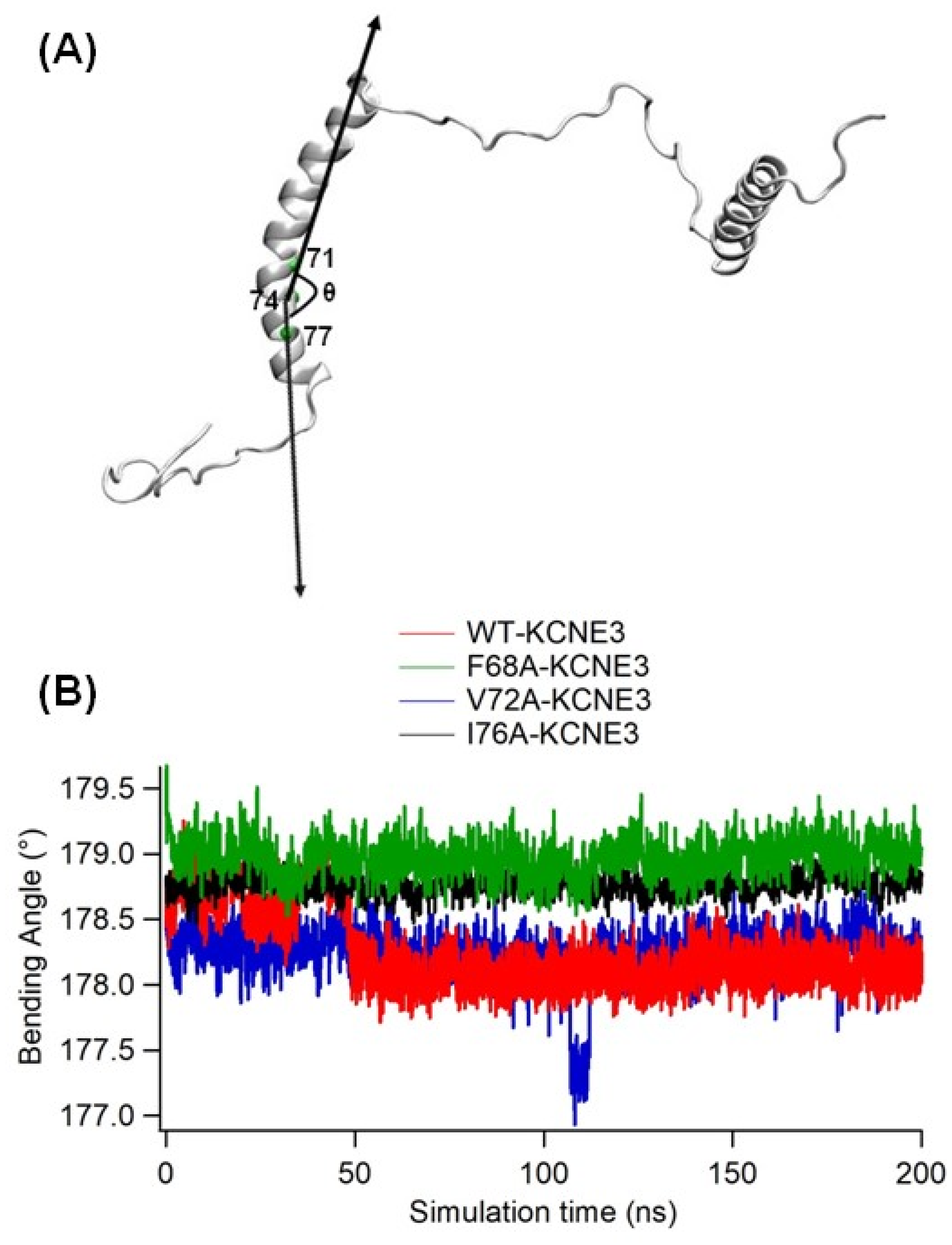
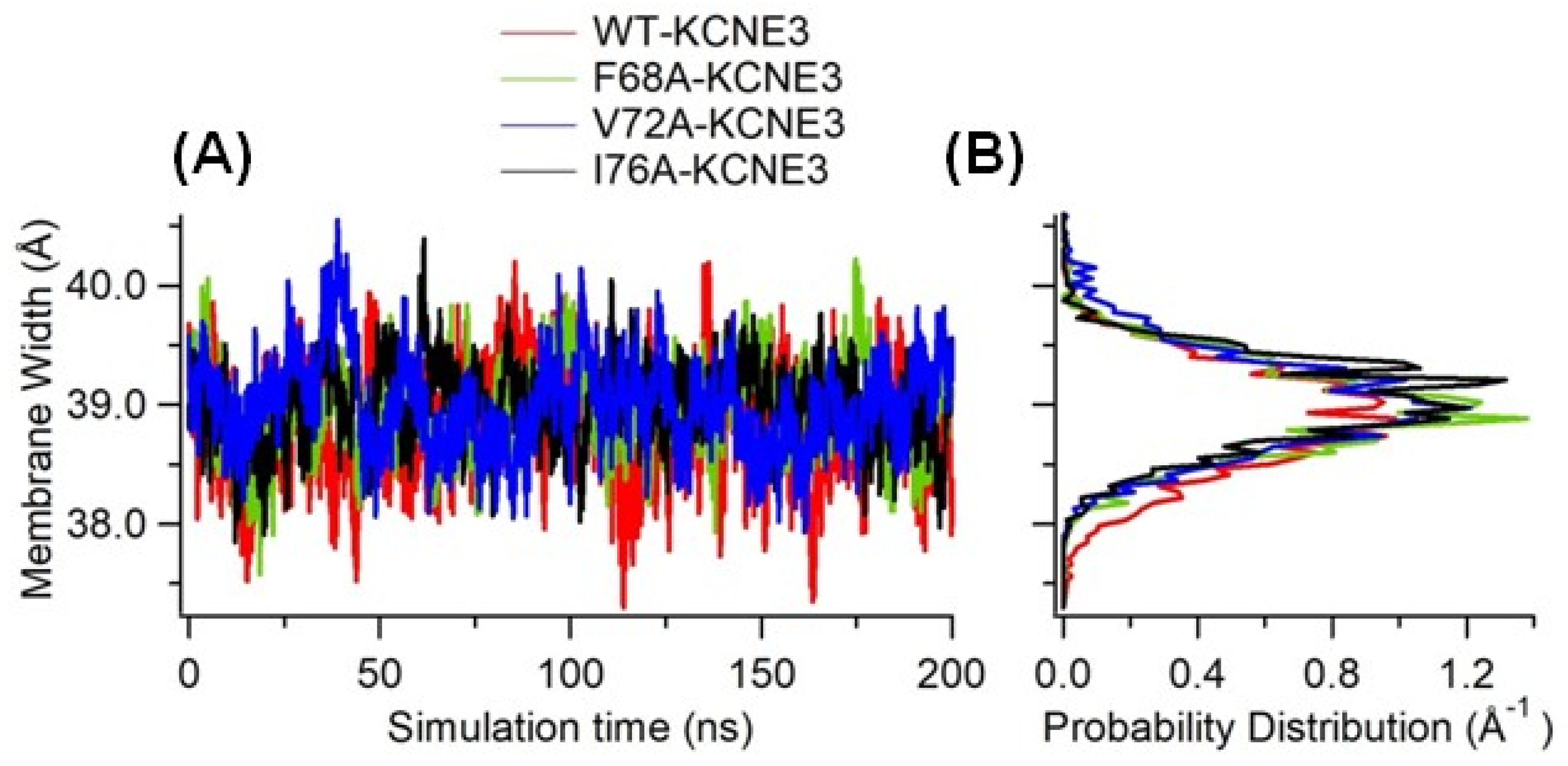
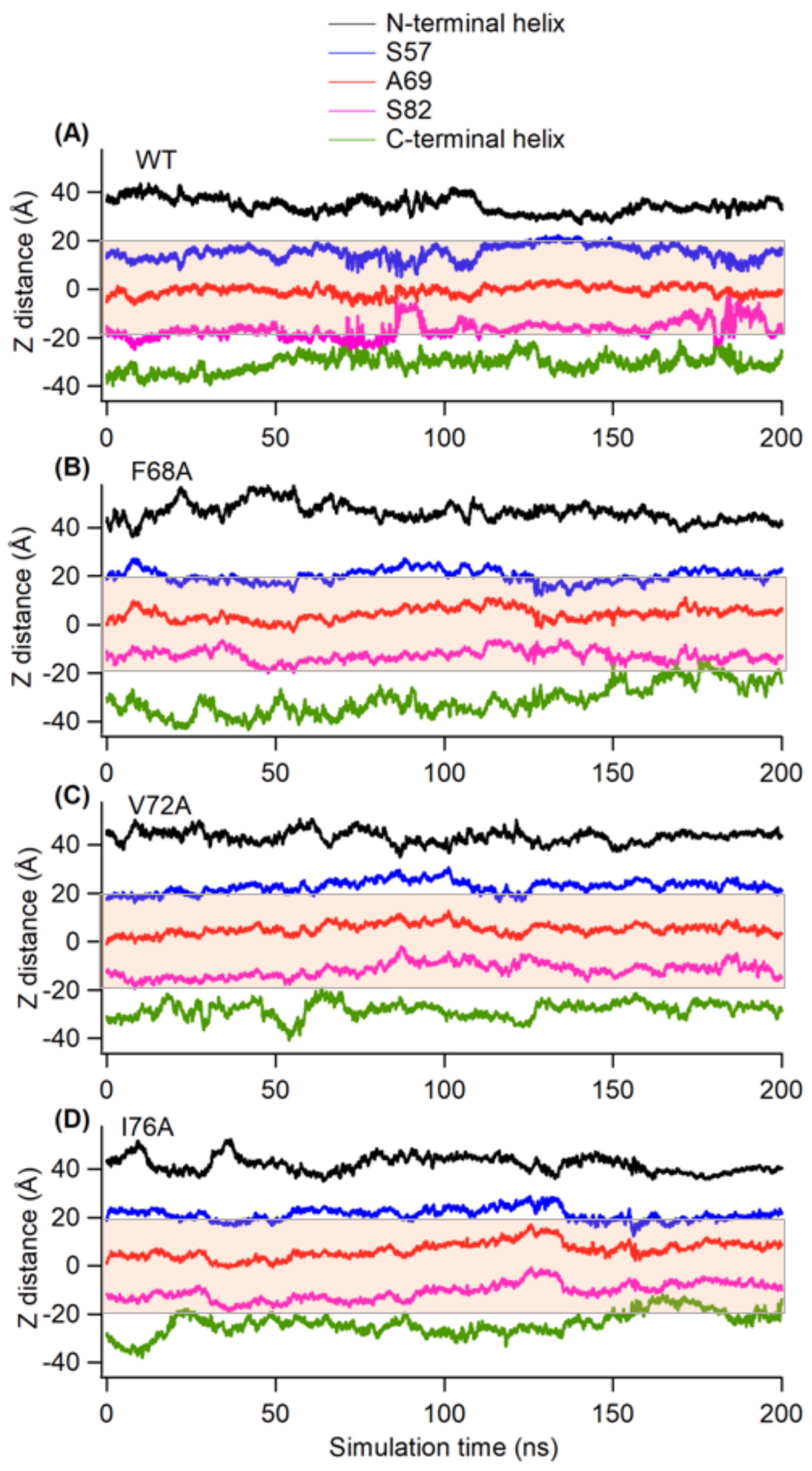
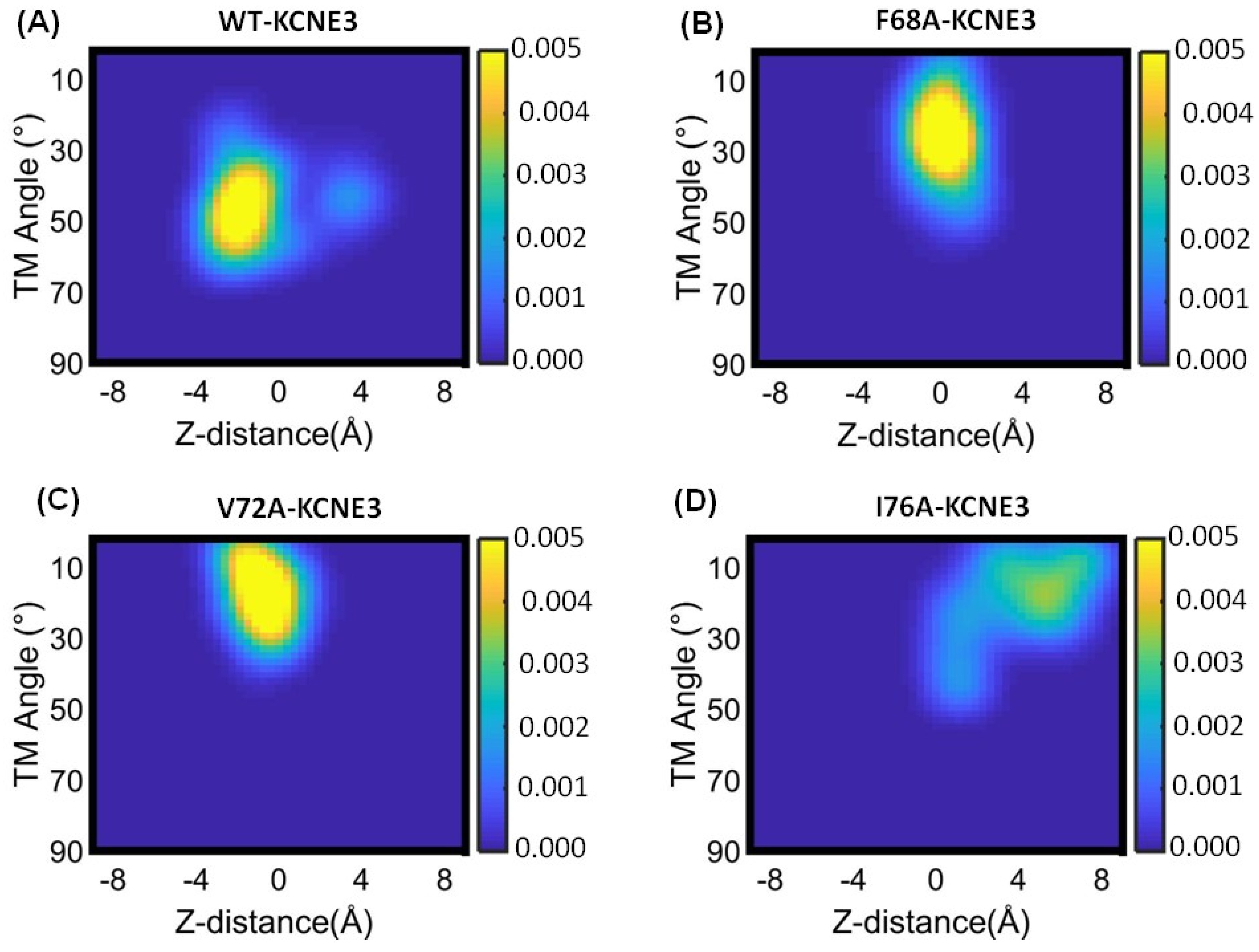
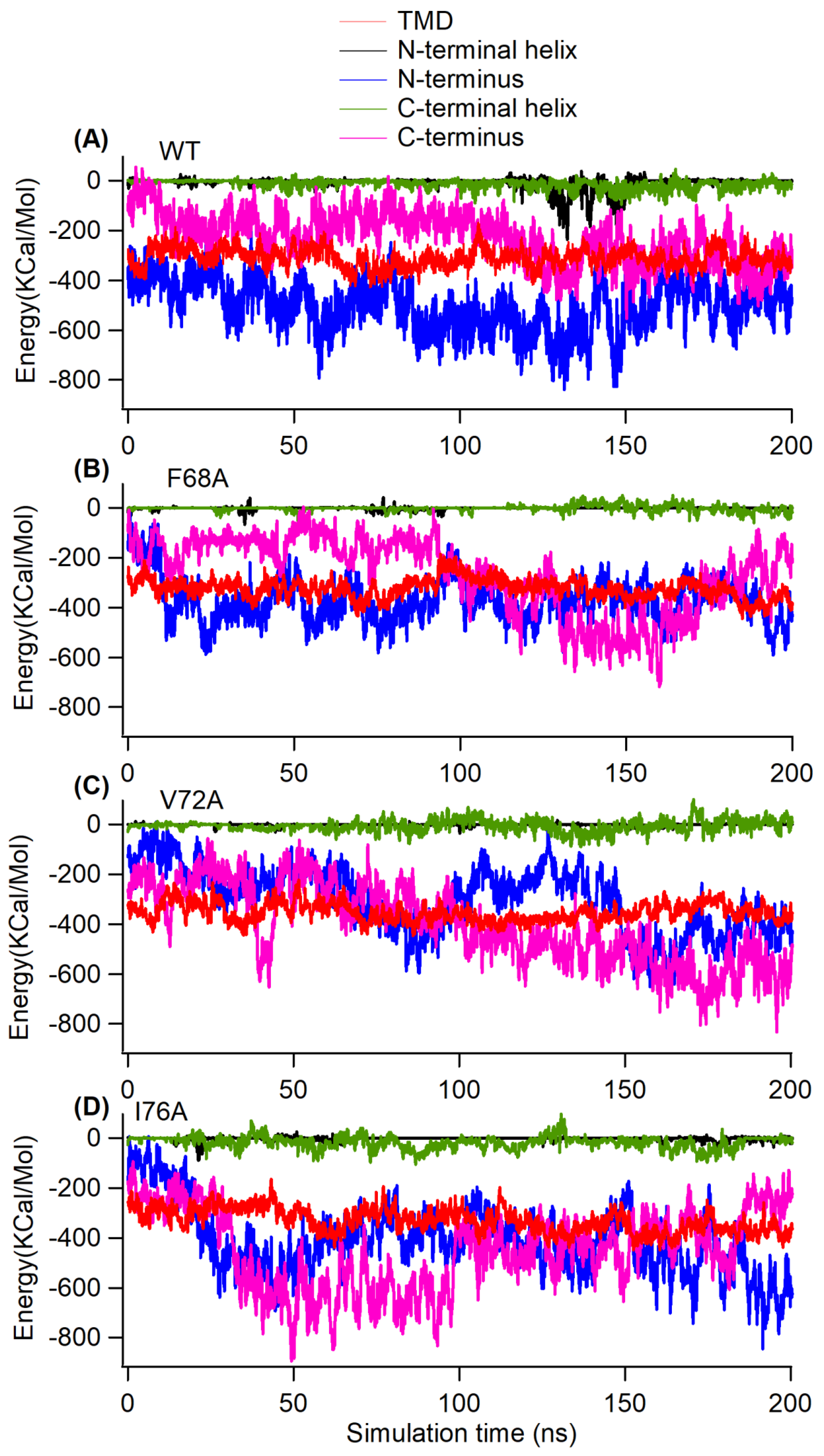

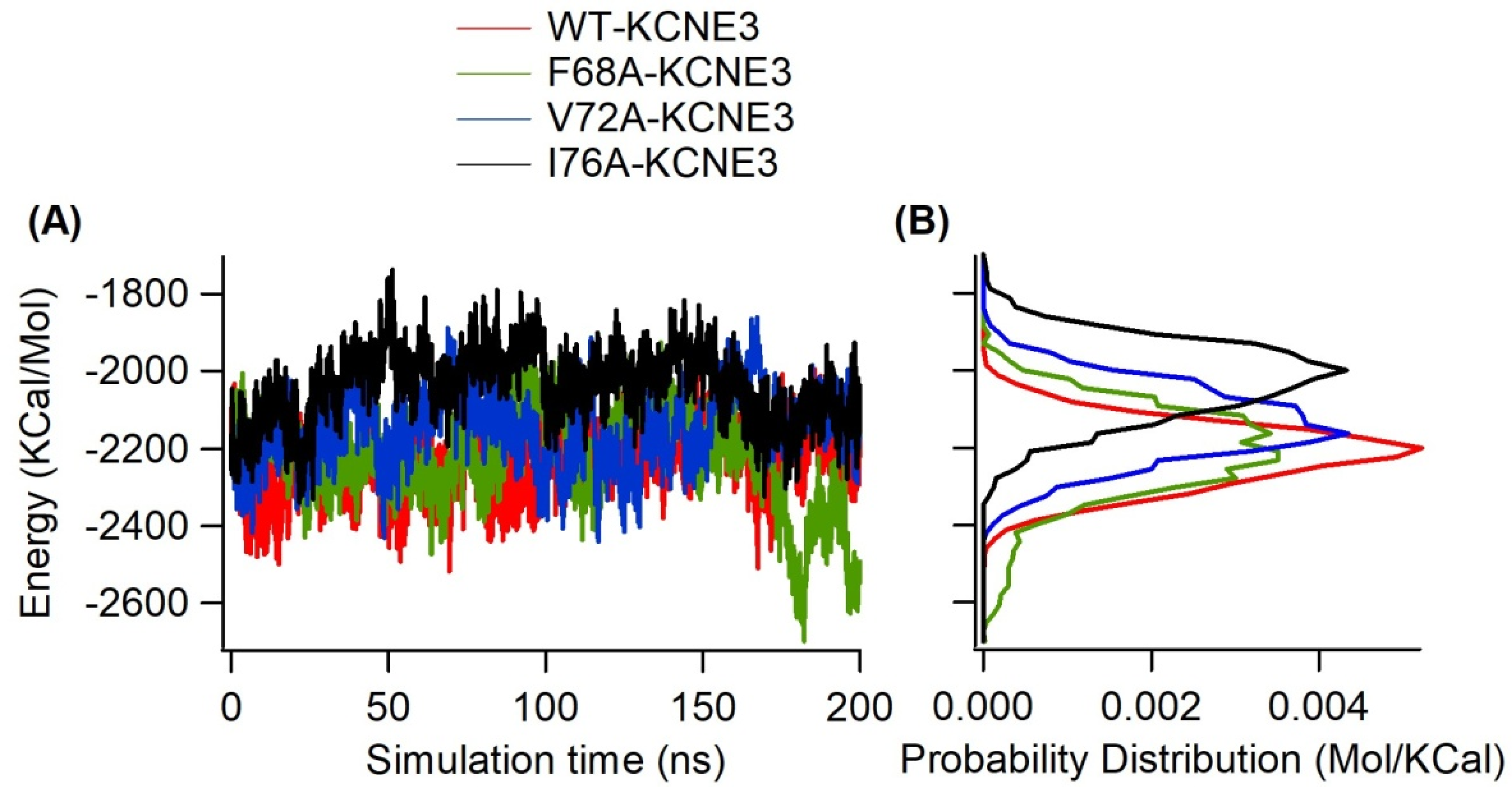
| System | System Size | Number of Water | Replica |
|---|---|---|---|
| WT-KCNE3 | 139.8 Å × 140.2Å × 149.3 Å | 56,806 | 2 |
| F68A-KCNE3 | 129.3 Å × 129.6 Å × 151.0 Å | 48,876 | 2 |
| V72A-KCNE3 | 129.5 Å × 129.2 Å × 151.0 Å | 48,955 | 2 |
| I76A-KCNE3 | 130.9 Å × 129.9 Å × 151.1 Å | 48.827 | 2 |
Disclaimer/Publisher’s Note: The statements, opinions and data contained in all publications are solely those of the individual author(s) and contributor(s) and not of MDPI and/or the editor(s). MDPI and/or the editor(s) disclaim responsibility for any injury to people or property resulting from any ideas, methods, instructions or products referred to in the content. |
© 2024 by the authors. Licensee MDPI, Basel, Switzerland. This article is an open access article distributed under the terms and conditions of the Creative Commons Attribution (CC BY) license (https://creativecommons.org/licenses/by/4.0/).
Share and Cite
Moura, A.C.M.; Asare, I.K.; Cruz, M.F.; Aguado, A.J.F.; Tuck, K.D.; Campbell, C.C.; Scheyer, M.W.; Obaseki, I.; Alston, S.; Kravats, A.N.; et al. Studying Conformational Properties of Transmembrane Domain of KCNE3 in a Lipid Bilayer Membrane Using Molecular Dynamics Simulations. Membranes 2024, 14, 45. https://doi.org/10.3390/membranes14020045
Moura ACM, Asare IK, Cruz MF, Aguado AJF, Tuck KD, Campbell CC, Scheyer MW, Obaseki I, Alston S, Kravats AN, et al. Studying Conformational Properties of Transmembrane Domain of KCNE3 in a Lipid Bilayer Membrane Using Molecular Dynamics Simulations. Membranes. 2024; 14(2):45. https://doi.org/10.3390/membranes14020045
Chicago/Turabian StyleMoura, Anna Clara Miranda, Isaac K. Asare, Mateo Fernandez Cruz, Antonio Javier Franco Aguado, Kaeleigh Dyan Tuck, Conner C. Campbell, Matthew W. Scheyer, Ikponwmosa Obaseki, Steve Alston, Andrea N. Kravats, and et al. 2024. "Studying Conformational Properties of Transmembrane Domain of KCNE3 in a Lipid Bilayer Membrane Using Molecular Dynamics Simulations" Membranes 14, no. 2: 45. https://doi.org/10.3390/membranes14020045
APA StyleMoura, A. C. M., Asare, I. K., Cruz, M. F., Aguado, A. J. F., Tuck, K. D., Campbell, C. C., Scheyer, M. W., Obaseki, I., Alston, S., Kravats, A. N., Sanders, C. R., Lorigan, G. A., & Sahu, I. D. (2024). Studying Conformational Properties of Transmembrane Domain of KCNE3 in a Lipid Bilayer Membrane Using Molecular Dynamics Simulations. Membranes, 14(2), 45. https://doi.org/10.3390/membranes14020045





